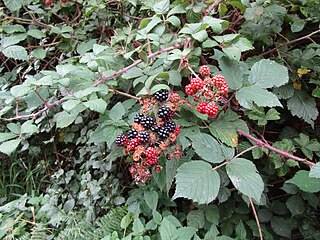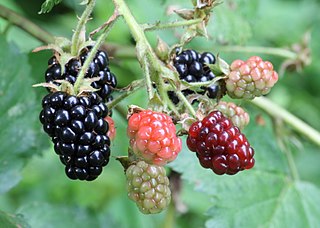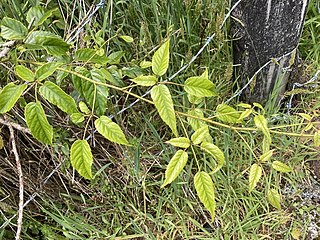
Rubus is a large and diverse genus of flowering plants in the rose family, Rosaceae, subfamily Rosoideae, with over 1,350 species, commonly known as brambles.

The blackberry is an edible fruit produced by many species in the genus Rubus in the family Rosaceae, hybrids among these species within the subgenus Rubus, and hybrids between the subgenera Rubus and Idaeobatus. The taxonomy of blackberries has historically been confused because of hybridization and apomixis, so that species have often been grouped together and called species aggregates. For example, the entire subgenus Rubus has been called the Rubus fruticosus aggregate, although the species R. fruticosus is considered a synonym of R. plicatus.

The raspberry is the edible fruit of a multitude of plant species in the genus Rubus of the rose family, most of which are in the subgenus Idaeobatus. The name also applies to these plants themselves. Raspberries are perennial with woody stems.

Rubus idaeus is a red-fruited species of Rubus native to Europe and northern Asia and commonly cultivated in other temperate regions.

Rubus spectabilis, the salmonberry, is a species of bramble in the rose family Rosaceae, native to the west coast of North America from west-central Alaska to California, inland as far as Idaho. Like many other species in the genus Rubus, the salmonberry plant bears edible fruit, typically yellow-orange or red in color, resembling raspberries in appearance.

Rubus phoenicolasius is an Asian species of raspberry in the rose family, native to China, Japan, and Korea.

Rubus caesius is a Eurasian species of dewberry, known as the European dewberry. Like other dewberries, it is a species of flowering plant in the rose family, related to the blackberry and raspberry. It is widely distributed across much of Europe and Asia from Ireland and Portugal as far east as Xinjiang Province in western China. It has also become sparingly naturalized in scattered locations in Argentina, Canada, and the United States.

Rubus occidentalis is a species of Rubus native to eastern North America. Its common name black raspberry is shared with other closely related species. Other names occasionally used include bear's eye blackberry, black cap, black cap raspberry, and scotch cap.

Rubus parviflorus, commonly called thimbleberry, is a species of Rubus native to northern temperate regions of North America. The plant has large hairy leaves and no thorns. It bears edible red fruit similar in appearance to a raspberry, but shorter, almost hemispherical. It has not been commercially developed for the retail berry market, but is cultivated for landscapes.

Rubus strigosus, the American red raspberry or American raspberry, is a species of Rubus native to much of North America. It was often treated as a variety or subspecies of the closely related Eurasian Rubus idaeus, but is now more commonly treated as a distinct species. Many of the commercial raspberry cultivars grown for their fruit derive from hybrids between R. strigosus and R. idaeus; see Raspberry for more details.

Rubus pensilvanicus, known commonly as Pennsylvania blackberry, is a prickly bramble native to eastern and central North America from Newfoundland south to Georgia, west as far as Ontario, Minnesota, Nebraska, and Arkansas. The species is also established as a naturalized plant in California.

Rubus armeniacus, the Himalayan blackberry or Armenian blackberry, is a species of Rubus in the blackberry group Rubus subgenus Rubus series Discolores Focke. It is native to Armenia and Northern Iran, and widely naturalised elsewhere. Both its scientific name and origin have been the subject of much confusion, with much of the literature referring to it as either Rubus procerus or Rubus discolor, and often mistakenly citing its origin as western European. Flora of North America, published in 2014, considers the taxonomy unsettled, and tentatively uses the older name Rubus bifrons.

Rubus ursinus is a North American species of blackberry or dewberry, known by the common names California blackberry, California dewberry, Douglas berry, Pacific blackberry, Pacific dewberry and trailing blackberry.

Rubus repens(dewdrop, false violet, star violet, Robin runaway. French Canadian: dalibarde rampante) is a perennial plant in the rose family, native to eastern and central Canada and to the northeastern and north-central United States. It is part of the genus Rubus, which includes brambles, blackberries, and raspberries. Some authorities consider it the sole member of a separate genus, Dalibarda. It is fairly easily grown in shady locations in damp to wet, acidic soils, and is frequently used in wildflower and bog gardens as a ground-cover.

Rubus nivalis, commonly known as snow raspberry, is a species of flowering plant in the rose family. It is native to northwestern North America: British Columbia, Washington, Idaho, Oregon, and far northern California.

Rubus cissoides, commonly called bush lawyer or tātarāmoa in te reo Māori, is a species of flowering plant in the family Rosaceae, endemic to New Zealand. Alan Cunningham described R. cissoides in 1839. Plants of this species of are perennial scrambling vines with compound leaves with 3-5 leaflets each up to 15 cm long, reddish prickles on the branches, white flowers from September to November and red berries from December to April. The conservation status of R. cissoides is Not Threatened, it is widespread on all three main islands of mainland New Zealand, and it has been used by Māori as food, medicines and construction materials.

Rubus pedatus is an Asian and North American species of raspberry known under the common names five-leaved bramble, strawberryleaf raspberry and creeping raspberry.

Rubus flagellaris, the northern dewberry, also known as the common dewberry, is a North American species perennial subshrub species of dewberry, in the rose family. This dewberry is distributed across much of Canada, Mexico, and the United States. It grows in diverse habitats ranging from drier savannas to temperate deciduous forests.

Rubus tricolor is an evergreen prostrate shrub, native to southwestern China. Leaves are dark green above, pale green below, and stems have red bristles. It has white flowers in summer and edible red fruit. It grows approximately 0.3 m (0.98 ft) high and usually forming a vigorously spreading, dense mat. In cultivation, it is mainly used as groundcover. Common names include Chinese bramble, groundcover bramble, creeping bramble, Korean raspberry, Himalayan bramble, and groundcover raspberry. In Chinese, it is called 三色莓.



















